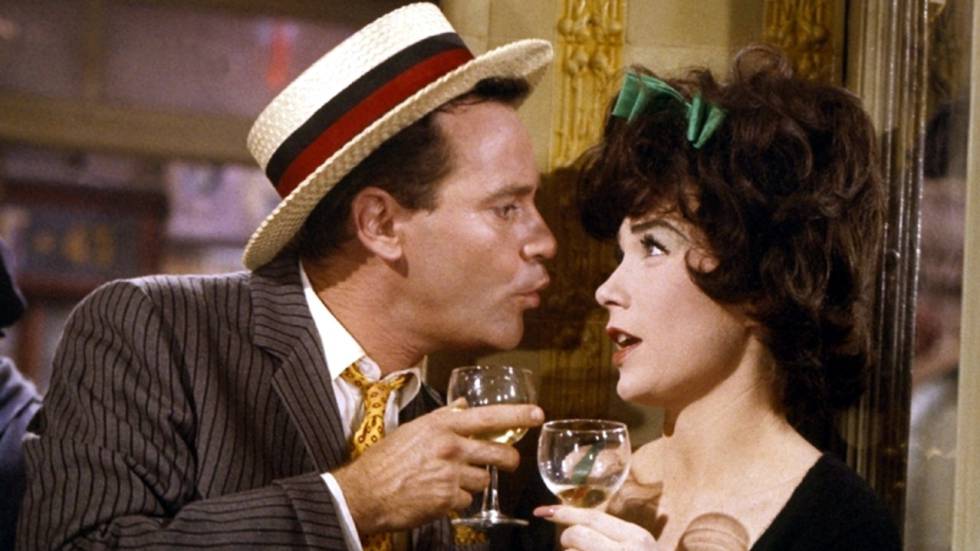After the success of 1960’s The Apartment, writer-director Billy Wilder re-teamed with stars Jack Lemmon and Shirley MacLaine for Irma La Douce, a 1963 romantic comedy about a prostitute and the man who falls in love with her and will do anything to keep her from walking the street.
The Production: 3.5/5
Billy Wilder’s production of Irma La Douce was a huge commercial hit upon its original release in 1963. Jack Lemmon and Shirley MacLaine have an obvious chemistry, as seen in 1960’s Academy Award winning film The Apartment. While the earlier film involved Lemmon’s character having to save MacLaine from sleeping with the lecherous men at their workplace, this time, MacLaine plays a prostitute (who happens to love her job) who Lemmon is once again determined to save. When the story begins, Lemmon is Nestor Patou, a lowly Paris cop new to the beat, and he decides to arrest an entire hotel full of prostitutes, who are using that location to make their living. But the police inspector, a client of said prostitutes, lets them go and fires Nestor for good measure. Down on his luck, Nestor ends up hanging out at a popular bar run by a man known only as Mustache (Lou Jacobi). The bar is in the same neighborhood as the hotel with the prostitutes, and Nestor soon friends Irma (Shirley MacLaine). After Nestor unintentionally defends Irma from her abusive pimp, he soon finds himself taking over that role. However, Nestor has become smitten with Irma, and wants to put an end to her prostitution days. After speaking with Mustache, a scheme is hatched where Nestor will pretend to be a wealthy Brit known as “Lord X,” and as Lord X, Nestor will give Irma enough money during each weekly visit so that she can take the rest of the week off. Of course, Irma soon begins falling for “Lord X,” while Nestor must frantically work grueling jobs around the clock to earn the money that “Lord X” gives to Irma. (That Irma never realizes “Lord X” is merely Nestor wearing a disguise is a given.)
Irma La Douce had a somewhat unusual trip from conception to screen. The story was originally a stage musical that began its life in France before moving to the West End and then Broadway. When the film rights were purchased, the initial idea had been to use the film as a vehicle for Marilyn Monroe, but her untimely death resulted in a change of plans, and MacLaine instead joined the cast. Billy Wilder, who wrote the screenplay with his frequent collaborator I.A.L. Diamond, decided to ditch the songs, turning a stage musical into a comedic feature.
Wilder is widely recognized not only as a master filmmaker but also as a comedic genius, with his films frequently displaying his singular wit. With I.A.L. Diamond, Wilder created some of the most intelligent, subversive and hilarious films of the mid-20th century. Wilder and Lemmon worked particularly well together, with the pair making seven films together. At their best (which would probably be Some Like It Hot or The Apartment), they created films that could nimbly alternate between moments of side-splitting laughter and subversive examinations of the conventions of everyday life. While both of those elements are occasionally on display in Irma La Douce, it is surprising how nimble this particular film isn’t. Running nearly two and a half hours, the film feels every moment of its excessive length, and is frequently dragged down by poor pacing that leaves the audience well ahead of where the characters are. It’s not that anything in it is particularly bad or wrong, but more of a case of the sum not being greater than the individual parts, and the slow pacing allowing time for the seams to show. In a shorter, faster paced film, for instance, the viewer might not have the time to question why an otherwise intelligent lady like Irma wouldn’t notice that Lord X is Nestor with some makeup on, even after she’s shared a bed with “both” men. And after a relatively simple first and second act, the third act arrives overstuffed with a court case and pregnancy that are played too seriously after the relative silliness of the film’s setup. Finally, the film ends on a twist about Lord X that simultaneously makes little sense while throwing the viewer into doubt about everything they’ve seen previously.
But if the pacing is sloppy and the screenplay not as strong as some of Wilder and Diamond’s other collaborations, the performances are never anything less than grand. Jack Lemmon handles his dual role with great agility, and it’s fun to see how his Nestor learns how to better play Lord X with each opportunity. MacLaine wholly owns the title role, imbuing Irma with a sense of class, sophistication and lack of shame that is atypical for a role of this type. (The opening sequence, which introduces the audience to Irma, her profession, and her tricks for getting better tips, is a wonderful demonstration of Wilder’s wit and humor, and MacLaine’s comic timing.) Of the supporting players, Lou Jacobi’s turn is most memorable.
Irma La Douce, though a major financial success for Wilder, is ultimately one of his lesser efforts. Though the cast is brilliant, and though the story has potential, the uneven pacing and excessive length result in a film that is less nimble than it should be, with story beats frequently drawn out longer than necessary. While it is by no means a bad work, the principle talents have all done better work elsewhere; they’ve even done better work together.
Video: 4.5/5
3D Rating: NA
Kino Lorber’s new disc of Irma La Douce presents the film in its original theatrical aspect ratio of 2.35:1, from a new 4K scan of the original negative created by MGM. On the whole, the image is generally very good. It’s very steady with good detail and clarity. There is some occasional mild speckling, but nothing obtrusive or distracting. This disc easily bests the previous DVD, but it still appears somewhat lacking to my eyes. The sharpness here seems a little less than what might be expected, and the color at times can seem a little muted. For a film that has a reputation as being sharp and vibrant, the disc didn’t seem to entirely reflect that. It’s by no means a bad transfer, and perhaps these are faults that are only noticeable on larger screens, but it is perhaps not the home run that was hoped for.
Audio: 4.5/5
The film’s monaural audio is presented via a lossless DTS HD-MA 2.0 track which my receiver decoded into the center channel. The audio is generally clean and clear, but there are times when the dialogue can sound a little harsh within the mix. Like the video transfer, this may be nitpicking, and the track is certainly good enough to enjoy the film.
Optional English subtitles are also included on the disc.
Special Features: 2.5/5
Audio Commentary by Film Historian Kat Ellinger – This is a difficult commentary track to critique because the goals of the commentator seemed at odds with what I was expecting from the track. Near the beginning, Ellinger says that she does not intend to talk about the production of the film or behind the scenes anecdotes, and she is true to her word. Most of this track is actually a loose, rambling dissertation on the history of sex and prostitution in mainstream cinema, with very little of the commentary’s running time devoted specifically to Irma La Douce. Ellinger spends a lot of time discussing Ernst Lubitch (a fantastic director, but also one who had no involvement with this particular film) and other unrelated films, often giving away key plot points without any warning. As a generalized discussion about how issues of sexuality were portrayed before the MPAA ratings system came into play, there are some interesting moments, but it’s astonishing how little of this track is actually about Irma La Douce.
Audio Commentary by Film Historian Joseph McBride – McBride’s commentary is the better of the two, but is not without fault. McBride’s comments are not scene specific, and he spends his time analyzing the film rather than detailing the production or providing any behind-the-scenes anecdotes. Though he occasionally goes off on a tangent (for instance, describing how the film so offended his religious upbringing that he walked out of the film three times in theaters before finally making it to the end), he is usually able to bring the focus back to the film itself. And like Ellinger, McBride spends a lot of time talking about the career of Ernst Lubitch, a man who did not direct this film, rather than focusing on Billy Wilder, the man who did.
Original Theatrical Trailer (03:53, SD) – Like the film itself, the trailer is overlong, but is unique in that it uses original animations to set up the film’s setting and story, only showing brief glimpses of the cast in the final seconds.
The disc also includes trailers for Witness For The Prosecution, One Two Three, The Private Lives Of Sherlock Holmes, Avanti and What A Way To Go, all but the latter also directed by Wilder.
Overall: 4/5
Kino Lorber’s new disc of Irma La Douce presents a brand new transfer of the film along with two newly recorded audio commentaries. While the transfer is a huge improvement over previous home video releases, it is perhaps not as perfect as hoped for. The two commentary tracks are of varying quality, and may not be satisfying to fans of the film looking to better understand its production history. Despite those flaws, this is a worthwhile presentation for fans of Wilder, Lemmon and MacLaine.
Josh’s fate as a physical media enthusiast was probably sealed the moment he figured out how to operate a top-loading VCR before he even knew how to walk. Since graduating with a degree in film production, he has enjoyed a career focused on the archival and distribution side of film and television. These days, Josh thinks of himself as a proud father of twins first. He would like to thank his wife for her unwavering support, and for every typo she’s ever caught.
Post Disclaimer
Some of our content may contain marketing links, which means we will receive a commission for purchases made via those links. In our editorial content, these affiliate links appear automatically, and our editorial teams are not influenced by our affiliate partnerships. We work with several providers (currently Skimlinks and Amazon) to manage our affiliate relationships. You can find out more about their services by visiting their sites.






Similar threads